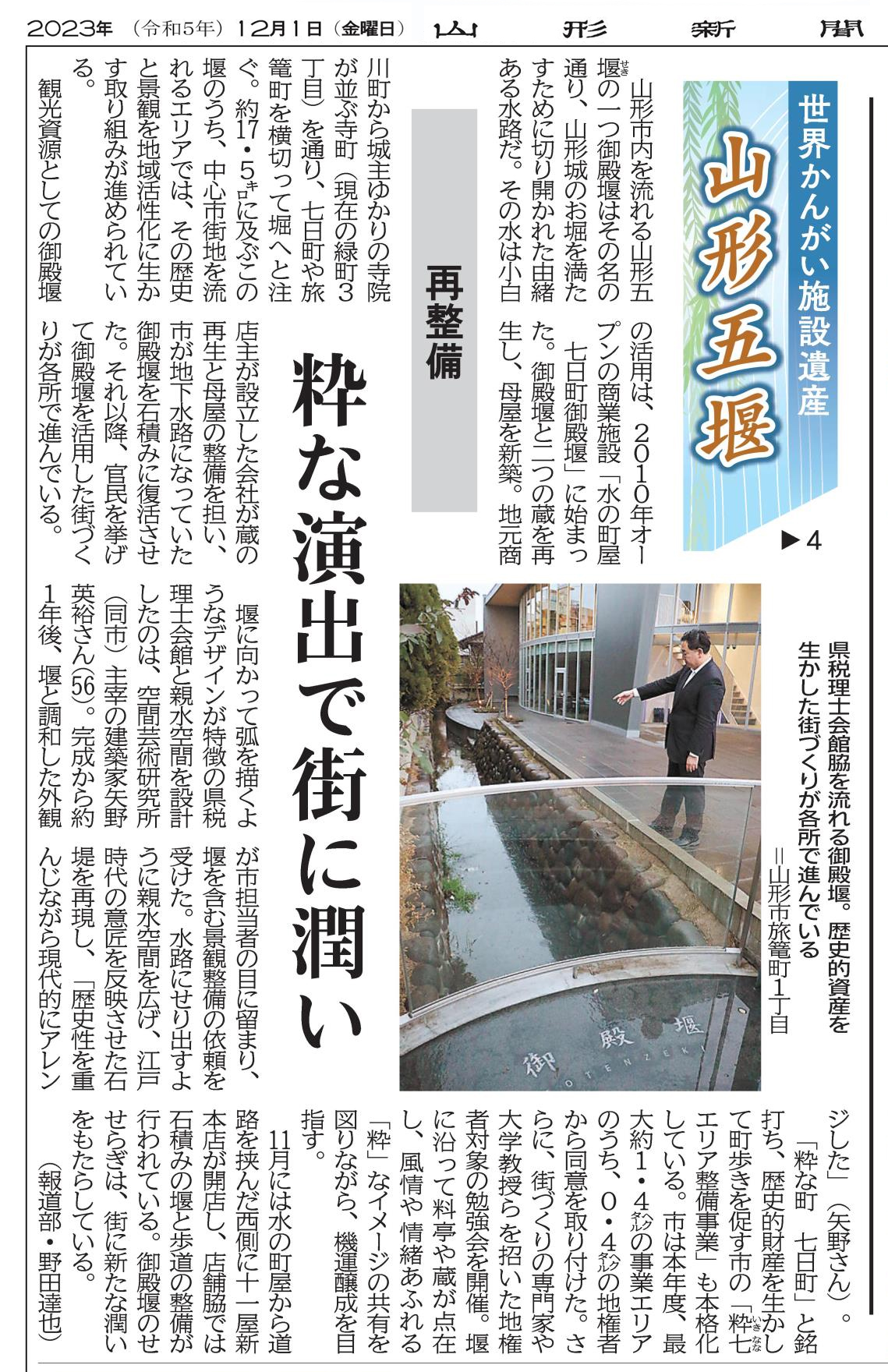山形市内を流れる山形五堰が、11月4日、世界かんがい施設遺産に選定されました。→山形新聞記事
山形五堰は、今から約400年前に、山形城主鳥居忠政が川の流路を変える工事を行った際、城の堀への導水と生活・農業用水の確保を目的につくったとされています。
11月28日から、5日連続で、山形新聞において、「世界かんがい施設遺産 山形五堰」の特集記事が組まれました。
その第四回目に、「再整備 粋な演出で街に潤い」というサブタイトルで、私が関わった、山形五堰のうちのひとつ、御殿堰の都市景観整備に関する内容を取り上げていただきました。
取材してくださった、記者の野田達也さん(山形新聞社)、ありがとうございました。
このたび、使用許諾がとれたので、このブログに転載します。

The following is the translation of the above Japanese newspaper article into English.
“World Irrigation Facility Heritage: The Yamagata Goseki (Five Historic Canals Flowing through Yamagata City)
Part Four ‘Redevelopment – Adding Elegance and Moisture to the City’
One of the Yamagata Goseki, the Goten-zeki canal, flows through Yamagata City. As its name suggests, it is a historic waterway created to fill the moat of Yamagata Castle. This waterway, originating from Kojirakawa-machi, passes through Teramachi (currently Midori-cho 3-chome), an area lined with temples associated with the castle lords, and then crosses Nanoka-machi and Hatago-machi before pouring into the moat. Of this approximately 17.5 km long canal, efforts are underway in the central city area to leverage its history and scenery for regional revitalization.
The utilization of Goten-zeki as a tourist resource began with the opening of the commercial facility ‘Mizu no Machiya Nanoka-machi Goten-zeki’ in 2010. The project involved renovating Goten-zeki and two storehouses, and constructing a new main house. A company founded by local shopkeepers took charge of the storehouse renovation and main house maintenance, while the city restored the Goten-zeki, which had been an underground waterway, into a stone-built canal. Since then, urban development utilizing Goten-zeki has been progressing in various places with the cooperation of both public and private sectors.
The design of the Prefectural Tax Accountant Association Hall, characterized by its curve towards the canal, and the waterside space were designed by Hidehiro Yano (56), an architect and head of “vectorfield architects ( Space Art Institute) ” (same city). About a year after completion, the building’s appearance, harmonizing with the canal, caught the attention of city officials, who then commissioned Yano for landscape development including the canal. He expanded the waterside space to jut into the canal and recreated the stone embankments reflecting the designs of the Edo period, “respecting history while adding a modern twist,” according to Yano.
The city’s ‘Ikinana Area Development Project,’ named ‘Stylish Town Nanoka-machi’ and aimed at promoting walking tours using historical assets, is also in full swing. This fiscal year, the city secured consent from landowners for 0.4 hectares of the project’s maximum 1.4-hectare area. Furthermore, the city organized study sessions for landowners, inviting urban development experts and university professors. The aim is to foster a shared vision of ‘stylishness,’ with the canal lined with traditional Japanese restaurants and storehouses, and to create a charming and emotional atmosphere.
In November, Juichiya Shin-Honten (New main shop) opened on the west side of Mizu no Machiya, across the road. Adjacent to the store, work is underway to develop the stone-built canal and pedestrian paths. The murmuring of the Goten-zeki canal is bringing new vitality to the city.” – (Reporting Department, Noda Tatsuya)
以下是上述日本语新闻文章的中文翻译。
“世界灌溉设施遗产:山形五渠(流经山形市的五条历史性溢水渠)
第四部分 ‘再整备 – 以巧妙演出为城市增添活力’
山形市内流淌的山形五渠之一的御殿渠,顾名思义,是为填满山形城堡的护城河而开凿的历史悠久的水道。这条水道从小白川町起,经过与城主有关的寺院林立的寺町(现绿町3丁目),穿过七日町和旅馆町,最终流入护城河。在这条约17.5公里长的渠道中,中心城区的区域正在利用其历史和风景促进地区振兴。
御殿渠作为旅游资源的利用始于2010年开业的商业设施‘水之町屋 七日町御殿渠’。项目包括翻修御殿渠和两个仓库,并新建了主楼。由当地商店主成立的公司负责仓库的翻修和主楼的维护,市政府将曾是地下水道的御殿渠恢复为石造水道。自那以后,政府和私人部门合作,利用御殿渠进行城市建设的工作在各地进行。
县税理士会馆的设计特点是朝向渠道弯曲,亲水空间的设计者是空间艺术研究所(同市)的主持建筑师矢野英裕先生(56岁)。大约一年后,与渠道和谐的外观引起了市政官员的注意,他们委托矢野先生负责包括渠道在内的景观整备。他将亲水空间扩展到水道中,重现了反映江户时代设计的石堤,‘在尊重历史的同时进行现代化改造’(矢野先生说)。
市政府的‘粋七(时髦的七日町)区域开发项目’以‘时髦的城镇 七日町’为名,旨在利用历史财产促进城镇游览,也正在全面展开。本财政年度,市政府从项目最大1.4公顷的区域中获得了0.4公顷地主的同意。此外,市政府为地主举办了研讨会,邀请了城市建设专家和大学教授。在渠道沿线散布着料亭和仓库,共同营造出充满风情和情感的‘时髦’形象,同时致力于营造氛围。
11月,水之町屋对面的西侧开设了十一屋新本店,店铺旁边进行了石造渠道和人行道的整修。御殿渠的潺潺声为城市带来了新的活力。” – (报道部门・野田达也)
다음은 위의 일본어 신문 기사를 한국어로 번역한 것입니다.
“세계 관개 시설 유산: 야마가타 고세키 (야마가타 시를 흐르는 5개의 역사적 물길)
제4부 ‘재정비 – 세련된演出으로 도시에 활력’
야마가타 시내를 흐르는 야마가타 고세키의 하나인 고텐제키는 그 이름에서 알 수 있듯이, 야마가타 성의 해자를 채우기 위해 개척된 유서 깊은 수로다. 이 수로는 코지라카와초에서 시작하여 성주와 관련된 절이 늘어선 테라마치(현재 미도리마치 3초메)를 지나, 나노카마치와 하타고마치를 가로지르며 해자로 흘러간다. 약 17.5km에 달하는 이 수로 중, 중심 도심을 흐르는 지역에서는 그 역사와 경관을 지역 활성화에 활용하는 노력이 진행되고 있다.
관광 자원으로서의 고텐제키 활용은 2010년에 개장한 상업 시설 ‘미즈노 마치야 나노카마치 고텐제키’에서 시작되었다. 고텐제키와 두 개의 창고를 복원하고, 본관을 신축했다. 지역 상점 주들이 설립한 회사가 창고 복원과 본관 정비를 맡았으며, 시는 지하 수로였던 고텐제키를 돌로 만든 수로로 부활시켰다. 그 후로, 관공서와 민간이 함께 고텐제키를 활용한 도시 건설이 여러 곳에서 진행되고 있다.
현세리사이카이관의 디자인은 운하를 향해 곡선을 그리는 것이 특징이며, 이 친수 공간은 공간 예술 연구소(동 시) 소장인 건축가 야노 히데히로(56세)가 설계했다. 완성 후 약 1년 뒤, 운하와 조화를 이루는 외관이 시 담당자의 눈에 띄어, 운하를 포함한 경관 정비 의뢰를 받았다. 수로로 뻗어 나가는 친수 공간을 확장하고, 에도 시대의 디자인을 반영한 돌 제방을 재현하며 ‘역사를 존중하면서 현대적으로 재구성했다'(야노 씨).
‘세련된 마을 나노카마치’라는 이름으로, 역사적 재산을 활용하여 도시 산책을 촉진하는 시의 ‘이키나나 지역 개발 사업’도 본격화되고 있다. 시는 올해, 최대 약 1.4헥타르의 사업 지역 중 0.4헥타르의 토지 소유자로부터 동의를 얻었다. 또한, 도시 건설 전문가와 대학 교수를 초청한 토지 소유자 대상의 공부 모임을 개최했다. 운하를 따라 일본식 식당과 창고가 점재하며, 분위기 있고 감정이 넘치는 ‘세련됨’의 이미지를 공유하며 분위기 조성을 목표로 하고 있다.
11월에는 미즈노 마치야 건너편 서쪽에 주이치야 신본점이 개장했으며, 매장 옆에서는 돌로 만든 운하와 보행로 정비가 이루어지고 있다. 고텐제키의 소리가 도시에 새로운 활력을 가져다주고 있다.” – (보도 부서, 노다 타츠야)

